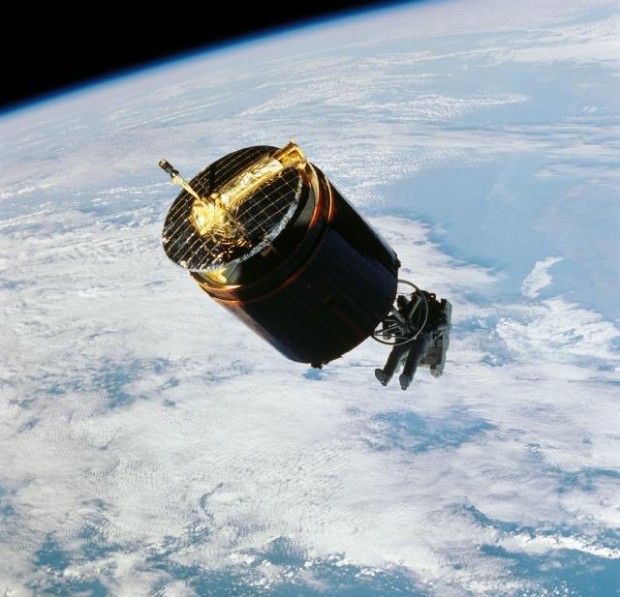An iconographic and text archive related to communication, technology and art.
☛ Great Images in NASA: “Satellites For Sale”, November 14, 1984. Image no. 51A-104-049, GRIN DataBase Number: GPN-2000-001036. The Johnson Space Center Imagery Service also host a copy of this photo. Click for a larger view. NASA as an even higher resolution reproduction (3000 x 1985 px). Public domain.
Blaise Pascal once wrote “The eternal silence of these infinite spaces frightens me.” (Pensée, § 206, tr. W.F. Trotter). For NASA’s astronauts, it seems to be quite the opposite: despite the high risks they entail (or perhaps because of it) each mission seems to be an opportunity for humor. The space agency archives are full of such examples: golfing on the moon, images of Playmates inserted in checklists, magic tricks, etc. The image above belong to this long tradition: a representant of humankind floating in the cold void of space protected only by a thin suit somehow finds the resources to crack a joke1.
• • •
Full official description from NASA:
Astronaut Dale A. Gardner, having just completed the major portion of his second extravehicular activity (EVA) period in three days, holds up a “For Sale” sign refering to the two satellites, Palapa B-2 and Westar 6 that they retrieved from orbit after their Payload Assist Modules (PAM) failed to fire. Astronaut Joseph P. Allen IV, who also participated in the two EVAs, is reflected in Gardner’s helmet visor. A portion of each of two recovered satellites is in the lower right corner, with Westar 6 nearer Discovery’s aft.
Two photos of the same scene were taken by astronaut Joseph P. Allen (using a 35mm camera). The one shown above is 51A-104-049. The other one is numbered 51A-104-050 (a small format is available through the JSC Imagery Service).
From November 8 to November 16 1984, NASA’s shuttle mission STS-51A involved using the space shuttle Discovery to deploy two satellites (one Canadian communication satellite and one defense communication satellite). But it also involved manually retrieving two malfunctioning satellites. For this special task, the shuttle first needed to perform a “precision chase” to catch up with the orbiting satellites. Then, during “extra vehicular activity” (or EVA) mission specialists Dale A. Gardner and Joseph P. Allen used “manned maneuvering units” (or MMU, propelled jetpack) to bring the satellites near the shuttle before the famous Canadarm (or Remote Manipulator System) could carefully place them inside the shuttle empty cargo bay. One of the malfunctioning satellite were later refurbished and, indeed, resold.
Below is a 70mm photograph of mission specialist Dale A. Gardner using his MMU to capture the Westar 6 satellite (the one that was resold). It was recently featured on NASA’s Astronomy Picture of the Day with the following captions:
In 1984, high above the Earth’s surface, an astronaut captured a satellite. It was the second satellite captured that mission. Pictured above, astronaut Dale A. Gardner flies free using the Manned Maneuvering Unit and begins to attach a control device dubbed the Stinger to the rotating Westar 6 satellite. Communications satellite Westar 6 had suffered a rocket malfunction that left it unable to reach its intended high geosynchronous orbit. Both the previously caught Palapa B-2 satellite and the Westar 6 satellite were guided into the cargo bay of the Space Shuttle Discovery and returned to Earth. Westar 6 was subsequently refurbished and sold.

The National Space Society has a 18 minutes video of the Space Shuttle Flight 14 (STS-51A) post flight presentation, narrated by the astronauts. It contains footage from the retrieval of the satellites (sequences from both EVAs involved in the retrieving of the satellites starts at 8’55”). Watch the relevant sequence below.
More information about this particular retrieval mission:
-
NASA has the summary of the mission STS-51A (dates, duration, key points, members, etc.)
-
The mission’s events are describe in details in the book NASA’s Scientist-Astronauts by David J. Shayler and Colin Burgess (Springer, 2006, pp. 400-407).
• • •
I first found the image posted over at NASA’s Astronomy Picture of the Day via Coudal’s Fresh Signal.
Previously, more NASA humor: “Seen any interesting hills & valley?”: Playmates On The Moon, 1969.
• • •
1. [UPDATE–March 17, 2013] A cartoon I spotted at the excellent blog Attempted Bloggery makes an excellent illustration for this point.

The caption reads: “Ah well, thank goodness we still have our sense of humour.” It was drawn by George Sprod in 1952 and republished on page 21 of the book A Century of Punch Cartoons (1955). See “Punch Cartoonists in Space” (March 13, 2013) for more information about this particular cartoon as well as other similar cartoons.↩︎︎
- By Philippe Theophanidis
- on
- ― Published in Communication, Technology
- Tagged: astronaut, Discovery, humor, NASA, satellite, shuttle, sign, space

